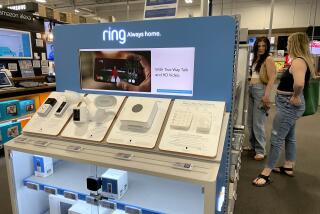Simple Is Better Than Smart for Gadgets
- Share via
I approach the medicine cabinet, and suddenly the mirror over the sink displays a Web page with the weather report.
After a few seconds, a message appears in the mirror advising me that the pollen count is high and suggesting I take my allergy medicine. As I fumble in the medicine cabinet for the pills, the mirror chimes and flashes a warning that I’ve taken the wrong bottle. After I retrieve the right bottle, the mirror reminds me of the proper dosage.
In truth, I don’t take allergy medicine. But the Online Medicine Cabinet is quite real, and actually works, using off-the-shelf components such as a flat panel display and machine-readable labels on the bottles.
It’s very Jetsonesque, but the circuitry has been built into a cruddy old wooden medicine chest designed to be mounted in the
bathroom. This seamless melding of old and new is both startling and easily understandable.
I expect we’ll see a lot more stuff like this over the next five years--simple concepts with simple technology that make our lives better.
I got to paw through the medicine chest of the future at a tech show in San Jose, where it was part of an exhibit on the future home coordinated by the Georgia Institute of Technology’s College of Computing.
The cabinet, developed by the Chicago-based consulting firm Accenture, was joined in this home of the future by doodads such as a remote control designed to be worn and to respond to hand gestures, a digitized picture that lets you see how active Grandma and Grandpa have been during the last few weeks and even a computerized system that keeps track of what ingredients you’ve put in the soup.
Most of these devices had a lot of rough edges, but as proof of concepts, they opened my eyes to what was possible. However, I wondered how many people really want something like this.
The New York World’s Fair in 1964 and 1965 displayed lots of visions of the future that were impossibly cool but were impractical, overpriced or simply not especially compelling to the vast majority of people.
My favorite example is the picture phone. A staple of science fiction, the picture phone broadcast a live, two-way picture in addition to the phone conversation. Strangely we don’t have picture phones today, despite the fact that the technology exists and is relatively cheap.
It turns out that most of us don’t actually want picture phones. Oh, sure, lots of us have cameras attached to our computers and some of us even use them occasionally to broadcast live video, but such uses are relatively rare.
I asked Elizabeth D. Mynatt, an assistant professor of computer science at Georgia Tech, what made the technology displayed in her exhibit different from the picture phone.
“The problem with the picture phone is that’s not how people actually use a phone,” she said.
People stare at the ceiling, doodle, flip through papers and even get up and walk around while on the phone. Engaging in such activities would be rude if the person talking to you over the telephone could also see you.
“The question you need to ask when you’re designing this stuff is whether it actually solves a problem or makes new problems,” Mynatt said. “The trick is to not try and make the technology super smart. People are super smart.”
That makes a lot of sense to me. What I need is fewer machines that try to think and more machines that simply do dependable grunt work, such as telling me where I tossed my keys--or whether I accidentally grabbed the wrong medicine bottle.
Of course, all these efforts to make our machines simpler will in fact lead to greater complexity. Simple, it turns out, is hard.
That key-finder concept would probably work best with a network of sensors scattered throughout the house.
There are, of course, key ring-size devices that chirp at you if you whistle the right tune or punch a button on a remote. But what I really want is something that will display a graphical representation of where my keys are located.
But even something as simple as that might have some problems. For instance, would we want the system to track people as they carried their car keys around? Clearly not. So the system would have to recognize the difference between somebody sitting on the couch with keys in their pocket and a set of keys that has fallen down behind the cushions.
What that means is, even with something as simple as a key tracker, we’re looking at a system that’s fairly complex and therefore more prone to glitches.
In contrast, the high-tech medicine cabinet is relatively simple. It doesn’t dispense the pills for me, which would require a complicated mechanism. Instead, it just reminds me of the right dosage, trusting that I can follow basic directions. As a backup mechanism, it’ll yelp if I grab the wrong bottle. Now that’s artificial intelligence.
I expect to someday be able to read the newspaper in the mirror above my sink while I’m brushing my teeth. Now if only somebody could come up with an automatic flossing machine.
*
Dave Wilson is The Times’ personal technology columnist.





